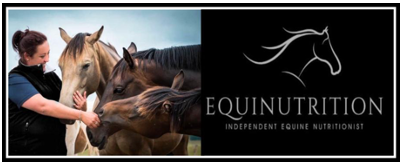“At Horslyx we spoke with Jennifer Little BSc Hons MSc RNutr at Equinutrition for her thoughts on nutrition through the summer months and ways to help our horses as biting and nuisance flies return.”
Compared with winter, having horses through the summer can seem a much more pleasant experience. 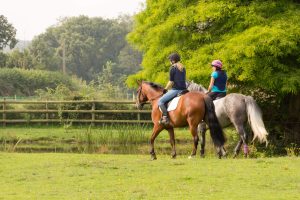 Long gone (hopefully) is the wading through mud, breaking ice on water troughs or buckets, fighting with wet heavy rugs, the requirement for increased hours of stable confinement and the reliance on dried forages. Instead, summer sees the return of longer, warmer days and for many, grass as the main component of their horse’s diet. However, with over 50% of the UK equine population being either over-weight or obese, this grass growth can be problematic [1]. For a significant number of owners, summer will see the need for measures to control grass intake. These measures might include grazing muzzles, restrictive grazing, the replacement of grass with fibre sources lower in energy and sugar content, such as soaked hay. For horses maintaining good body condition on grass and for those needing to be
Long gone (hopefully) is the wading through mud, breaking ice on water troughs or buckets, fighting with wet heavy rugs, the requirement for increased hours of stable confinement and the reliance on dried forages. Instead, summer sees the return of longer, warmer days and for many, grass as the main component of their horse’s diet. However, with over 50% of the UK equine population being either over-weight or obese, this grass growth can be problematic [1]. For a significant number of owners, summer will see the need for measures to control grass intake. These measures might include grazing muzzles, restrictive grazing, the replacement of grass with fibre sources lower in energy and sugar content, such as soaked hay. For horses maintaining good body condition on grass and for those needing to be 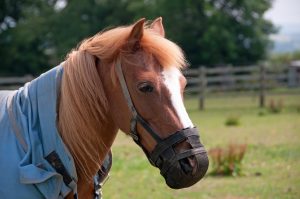 restricted to prevent obesity, it is highly unlikely that they will require additional food in the form of a bucket feed. They will however require a source of vitamins and minerals to supply the micro-nutrients likely to be missing from forage sources alone. This could be provided from a suitable fully fortified chaff, a balancer, or a vitamin and mineral supplement. For horses out in paddocks or on track systems, feed blocks such as Horslyx Balancers can be an effective and convenient way of supplying these vitamins and minerals, without the need for separate bucket feeds.
restricted to prevent obesity, it is highly unlikely that they will require additional food in the form of a bucket feed. They will however require a source of vitamins and minerals to supply the micro-nutrients likely to be missing from forage sources alone. This could be provided from a suitable fully fortified chaff, a balancer, or a vitamin and mineral supplement. For horses out in paddocks or on track systems, feed blocks such as Horslyx Balancers can be an effective and convenient way of supplying these vitamins and minerals, without the need for separate bucket feeds.
Unfortunately, summer also sees the return of numerous types of insects that pester and bite. 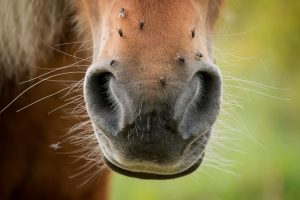 Horses grazing at pasture, or on track systems, are commonly the most affected by the presence of these insects, and they can be more than a simple nuisance. They are of significant veterinary importance, due to their nuisance value and their role as disease vectors [2]. Biting insects elicit an inflammatory response in the horse. Whilst an inflammatory reaction is a normal response, the duration and extent of the response can be significant enough to result in reactions of the immune system and to alter the horses behaviour [3; 4].
Horses grazing at pasture, or on track systems, are commonly the most affected by the presence of these insects, and they can be more than a simple nuisance. They are of significant veterinary importance, due to their nuisance value and their role as disease vectors [2]. Biting insects elicit an inflammatory response in the horse. Whilst an inflammatory reaction is a normal response, the duration and extent of the response can be significant enough to result in reactions of the immune system and to alter the horses behaviour [3; 4].
While biting, each of these blood-feeding insects will shed, secrete or excrete proteins called antigens, most commonly from their saliva. These antigens are capable of causing an inflammatory and immune response, both innate and adaptive within the horse, frequently resulting in clinical signs of itch-induced scratching [4]. This scratching can cause further inflammation and immunity responses, causing the cycle of increasing scratching behaviours. As the number of bites increase and as duration of exposure to bites exceeds a month, the severity of a horse’s reaction to new bites can also increase [4].
The intensity of a horse’s reaction to insect bites can be individualised to the horse or even the species of insect responsible for the bite. Some individuals can mount a detrimental response to the antigens within the saliva of biting insects, known as Insect Bite Hypersensitivity (IBH). Several species are known to cause IBH in horses, and these include horse flies (Tabanidae), stable flies (Stomoxys), mosquitoes 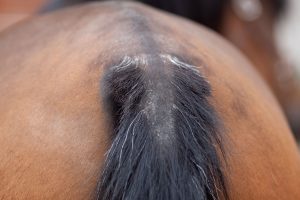 (Culicidae) and most commonly midges (Culicoides) . With the latter known to cause one of the most common skin conditions, commonly known as Sweet Itch [4]. IBH presents with localised inflammation, hair loss and tissue damage from bite-induced scratching. Areas frequently affected include the face, crest, wither, tail, tail head, and under-belly.
(Culicidae) and most commonly midges (Culicoides) . With the latter known to cause one of the most common skin conditions, commonly known as Sweet Itch [4]. IBH presents with localised inflammation, hair loss and tissue damage from bite-induced scratching. Areas frequently affected include the face, crest, wither, tail, tail head, and under-belly.
Even non-biting insect species are not free from health threats for our horses. Most obviously, they can bother the horse to the point of creating changes in behaviours and reducing grazing time. This can negatively impact on a horse’s body condition and digestive health. These non-biting insects can also transfer bacteria and viruses from the environment to a horse, and from horse to horse, posing an infection risk. While the majority of horses appear to cope remarkably well with the seasonal onslaught of flying insects and only a few are unfortunate enough to develop IBH, the mere presence of these insects can result in horses displaying annoyance behaviours, which can be stressful for owners [5].
Management of horses in the presence of biting and nuisance insects
There are several methods employed to protect horses from biting and non-biting flies, in the hope to alleviate and reduce annoyance behaviours [5]. These include physical barriers in the form of fly sheets and masks, topical sprays and treatments, insecticides, biological by using bat boxes to increase bat numbers, limiting turnout and diet supplementation.
The use of fly rugs and masks can be effective, but they can be easily damaged, prove expensive and in hot temperatures some horses may find wearing them problematic. It is unfortunately unrealistic to apply topical repellents to 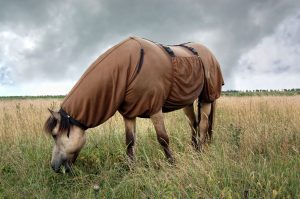 cover all exposed areas, and they are not suitable for application on to sensitive areas such as the eyes. These often have too short a duration of effectiveness, and they can be removed with sweating, grooming or hosing off [2]. Insecticides pose the possibility of horses developing sensitivities over time, and they often have the potential to impact the environment. Trying to establish a population of flying insect-eating predators, such as bats, can take time and investment in order to be effective. The use of dietary supplementation for the treatment of inflammation is generally considered safe, inexpensive and widely acceptable, but further research is required to determine efficacy [3;6]. However, the use of natural plant-based supplements for reducing insect challenge and for the management of inflammatory reactions has been documented since ancient times [3]. Probably, the plant most cited throughout history is garlic [7].
cover all exposed areas, and they are not suitable for application on to sensitive areas such as the eyes. These often have too short a duration of effectiveness, and they can be removed with sweating, grooming or hosing off [2]. Insecticides pose the possibility of horses developing sensitivities over time, and they often have the potential to impact the environment. Trying to establish a population of flying insect-eating predators, such as bats, can take time and investment in order to be effective. The use of dietary supplementation for the treatment of inflammation is generally considered safe, inexpensive and widely acceptable, but further research is required to determine efficacy [3;6]. However, the use of natural plant-based supplements for reducing insect challenge and for the management of inflammatory reactions has been documented since ancient times [3]. Probably, the plant most cited throughout history is garlic [7].
Garlic
Garlic has long been used as a medicine to treat a variety of illnesses and to boost the immune system [6]. The biological activity and anti-![]() inflammatory effects of garlic have been attributed in a number of studies to the biomolecules that garlic contains, and the ability of these molecules to inhibit inflammatory cytokines [3]. The biomolecules within garlic are collectively known as organosulphur compounds, which are non-protein amino acids [7]. The pharmacological effects of garlic include anti-microbial, improved intestinal microbes, antioxidant, and anti-inflammatory [7]. In human studies, the supplementation of garlic has been shown to reduce the body’s response to fly bites and therefore control the perceived level of irritation. This indicates that it may not be the number of bites, but the intensity of the body’s reaction to the bite, which makes the difference to the individual [4].
inflammatory effects of garlic have been attributed in a number of studies to the biomolecules that garlic contains, and the ability of these molecules to inhibit inflammatory cytokines [3]. The biomolecules within garlic are collectively known as organosulphur compounds, which are non-protein amino acids [7]. The pharmacological effects of garlic include anti-microbial, improved intestinal microbes, antioxidant, and anti-inflammatory [7]. In human studies, the supplementation of garlic has been shown to reduce the body’s response to fly bites and therefore control the perceived level of irritation. This indicates that it may not be the number of bites, but the intensity of the body’s reaction to the bite, which makes the difference to the individual [4].
The belief that dietary garlic can repel biting flies is well documented and it is routinely added to horses’ diets to reduce the number of fly bites, with apparent success [2]. This effect has not been shown with relation to internal parasites, and garlic supplementation should not be considered as part of a worming programme [8]. In relation to nuisance flies, the supplementation of garlic in animals has demonstrated the effect of reducing the number of flies found on their faces, and in reducing the incidence of infectious disease in animals housed in groups [9]. The supplementation of animal feed products with garlic is consistent with a modern approach to animal husbandry [7].
With such a large proportion of horses and ponies on the UK having their fibre, protein, and calorie requirements met by summer grazing, the addition of a vitamin and mineral balancer block that also contains garlic oil, such as Horslyx Garlic Balancer, could be a suitable feeding approach for many.
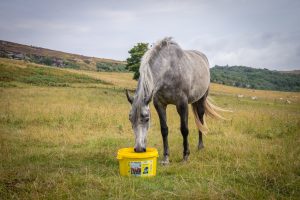
References
1 Knowles, E. & Grieve, L. 2020 Clinical insights: Equine obesity. Equine Veterinary Journal (10) 1111
2 Rajan, T.V., Hein, M., Porte, P., Wikel, S. 2005 A double-blind placebo-controlled trial of garlic as a mosquito repellent: a preliminary study. Medical and Veterinary Entomology (19) 84-89
3 Radovanovic, K., Gavaric, N., Acimovic, M. 2023 Anti-inflammatory properties of plants from Serbian traditional medicine. Life (13) 874
4 Wilson, A.D. 2014 Immune responses to ectoparasites of horses, with a focus on insect bite hypersensitivity. Parasite Immunology (36) 560-572
5 Wagner ,A.L., Rowland, R.E., Girard, I.D., 2022. 101 Impact of Equi-shield as a nutraceutical fly protectant in adult horses. Journal of Equine Veterinary Science (100) 103564
6 Tesfaye, A. 2021. Revealing the therapeutic uses of garlic (Allium sativum) and its potential for drug discovery. The Scientific World Journal. 8817288
7 Chen, J., Wang, F., Yin, Y., Ma, X. 2021. The nutritional applications of garlic (Allium sativum) as a natural feed additive in animals. PeerK 9:e11934
8 Burke, J., Wells, A., Casey, P., Miller, J.E. 2009. Garlic and papaya lack control over gastrointestinal nematodes in goats and lambs. Veterinary Parasitology 159 (2): 171-174
9 Huang, R.H., Qiu, X.S., Shi, F.X., Hughes, C.L., Lu, Z.F., hu, W.Y. 2011. Effects of dietary allicin on health and growth performance of weanling piglets and reduction in attractiveness to faeces to flies. Animal 5 (2): 304-311

![]()

